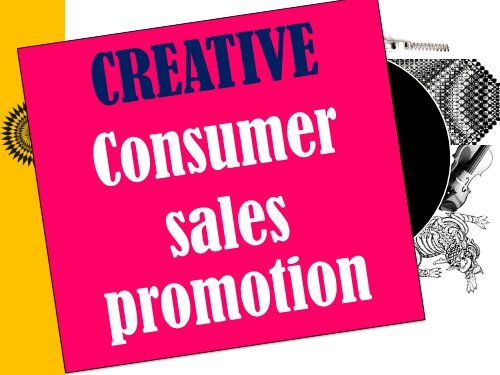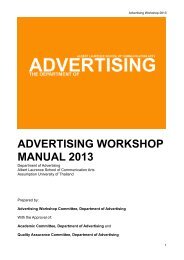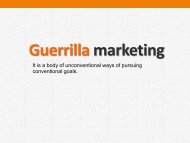Sales Promotion - Advertising
Sales Promotion - Advertising
Sales Promotion - Advertising
You also want an ePaper? Increase the reach of your titles
YUMPU automatically turns print PDFs into web optimized ePapers that Google loves.
<strong>Sales</strong> <strong>Promotion</strong><br />
<strong>Advertising</strong><br />
Events and experience<br />
Public relations and publicity
Consumer<br />
Rewards<br />
�Price deal<br />
�Discount<br />
�Bonus pack<br />
�Refund/Rebate<br />
�Coupon<br />
�Sampling<br />
�Premium<br />
�Contest/Sweepstakes program<br />
�Continuity
Issues<br />
Creative Brief for Consumer <strong>Sales</strong> <strong>Promotion</strong><br />
-Objective<br />
-Target audience<br />
-Current position<br />
-Repositioning<br />
-Features/Benefits<br />
-Key selling point
Message strategies<br />
A message strategy is the primary tactic or<br />
approach used to deliver the message theme.<br />
There are 3 broad categories of message strategies.<br />
1. Cognitive strategies<br />
2. Affective strategies<br />
3. Conative strategies
<strong>Advertising</strong> Appeals<br />
Fear<br />
Humor<br />
Sex<br />
Music<br />
Rationality<br />
Emotionality<br />
Scarcity
Fear<br />
concentrates on emotional responses<br />
from customers to a perceived threat,<br />
typically severity and vulnerability.<br />
Earlier, fear appeal is used when some negative<br />
behavior is usually associated with a negative effect,<br />
like smoking and lung cancer.<br />
Lately, the communicator will try to persuade the<br />
audience in avoiding the negative effect by<br />
practicing the positive behavior.
Fear<br />
Fear increases interest and is<br />
remembered.<br />
Severity and vulnerability<br />
Severity – level of consequence<br />
Vulnerability – probability of event occurring<br />
Response efficacy<br />
Response costs<br />
Self-efficacy
Antidrug
Buy one get one<br />
killed<br />
Creative: Dan Neri and Scott Murray of Matter<br />
Director: Steven Tsuchida of Oil Factory
Silent scream
Listerine
Fear<br />
Pro - Fear appeals tend to be very persuasive and<br />
are great for capturing peoples attention<br />
Con- hard to gauge how much fear to use, too<br />
much and you can scare people away from your<br />
ads and too little fear and nobody will notice your<br />
ad.
Humor<br />
Try to make people laugh and feel<br />
amused by the ad.<br />
People like to tell jokes and talk about funny<br />
commercials; doing so further helps memorizing.<br />
Advertisers must also be culturally aware as what<br />
is funny in one culture may be offensive in<br />
another.
CP<br />
S
Interesting<br />
issue<br />
�One reason for the success of humor in<br />
advertising may be that the population is<br />
AGING.<br />
�According to Abraham Maslow, people tend<br />
to develop more comedic view of life as they<br />
are MATURE.<br />
�Also, humor helps individuals adjust<br />
situations they can’t control and to cope with<br />
life’s problems.<br />
�Laughing allows individuals to escape from<br />
reality.
KT bank<br />
S
Humor<br />
Pro- Humor is one of the best methods for<br />
cutting through advertising clutter as funny<br />
ads are more easily noticed. Humor gets<br />
attention, stays in peoples memories.<br />
Con-<br />
It is important that the joke does not overpower the<br />
brand, if people remember the joke but not the brand<br />
this is not effective.<br />
-A joke can make the brand looks foolish.
Sappe<br />
S
Sex<br />
The use of sex can be<br />
subliminal, sexually<br />
suggestive, nudity or<br />
sensuality.<br />
Another universal aspect of being<br />
human, sex has been used for years by<br />
marketers to capture attention of the<br />
sexes.<br />
In several notable cases, sex in<br />
advertising has been claimed as<br />
the reason for increased<br />
consumer interest and sales.
1871 : The earliest known use of sex in<br />
advertising is by the Pearl<br />
Tobacco brand which featured a<br />
naked maiden on the package<br />
cover.
1885,<br />
W. Duke & Sons<br />
inserted trading cards<br />
into cigarette packs<br />
that featured sexually<br />
provocative starlets.<br />
Duke grew to become<br />
the leading cigarette<br />
brand by 1890 (Porter,<br />
1971).
1910 : Woodbury's Facial Soap, a woman's beauty bar, was<br />
almost discontinued. The soap's sales decline was reversed,<br />
however, with ads containing images of romantic couples and<br />
promises of love and intimacy for those using the brand<br />
(Account Histories, 1926).
Food and<br />
Drink
Food and<br />
Drink
Food and<br />
Drink
Fashion
Fashion
Technology
Detergent
Detergent
Shiseido
Sex<br />
Pro- Sex is proven to cut through clutter, if<br />
your advertising in a busy time-slot using sex<br />
appeals will help your ad get noticed, this<br />
helps increase brand recognition.<br />
Con-<br />
Sex appeals can be provocative and may cause negative<br />
reactions with among some audience groups.<br />
It sometimes make the ad looks cheap
Banned<br />
Sprite<br />
Germany<br />
http://www.youtube.com/watch?v=0mOIhNiJJD8&<br />
feature=related
Special issue<br />
• Some ad aims at tuning down the negative<br />
effects brought by sexual appeal by adding<br />
humorous element in the advertising<br />
message.<br />
• By combining different appeals, somehow the<br />
advertisers can retain the merits of one appeal<br />
and avoid deficit by adding another appeal.
Oishi
Music is something that everyone enjoys, music is<br />
something that is both personal and causes people<br />
to recall moments that are both good and bad in<br />
their life.<br />
Music<br />
Music helps capture<br />
attentions and link to<br />
the consumers<br />
emotions.
It is far more likely to memorize a piece<br />
of music than spoken language or<br />
images because “music tends to linger<br />
in the listeners mind.”<br />
“Forever,” by Chris Brown along with a<br />
new version of the venerable jingle for<br />
Doublemint gum; the song is a longer<br />
version of the jingle.<br />
Double Mint gum
The trend is gaining favor for a couple<br />
of reasons.<br />
• On the side of musicians, marketers can help<br />
generate exposure for new songs, which struggle<br />
to gain attention because of the decline in CD<br />
sales, radio play, and retail outlets.<br />
• On the side of marketers, the trend fits in with<br />
the rise of what is called branded entertainment,<br />
by which a product seeks to link itself in the<br />
minds and hearts of consumers with movies, TV<br />
shows or songs they like.
Failure matching<br />
• “There is road kill along this path” — that is,<br />
hook-ups between musicians and brands that<br />
were deemed poor fits, inappropriate or over<br />
commercialized.<br />
• There is an agreement in 2002 between Celine<br />
Dion and Chrysler which Chrysler ended two<br />
years early because the company had<br />
determined the partnership stimulated sales<br />
of her music more than sales of its cars.
The entertainment aspect of music<br />
helps making an advertisement more<br />
appealing to the viewer by simply<br />
making it more attractive respectively<br />
more aesthetic<br />
I Drove All Night by Celine Dion<br />
Chrysler
Pro- sing a well known song can bring back<br />
positive nostalgic memories in consumers<br />
causing them to have positive attitudes<br />
Music<br />
towards your brand, music's intrusive nature<br />
means that people can still be attracted to the<br />
ad even if they are avoiding ads in general.<br />
Con-<br />
Certain music can cause negative reactions in consumers<br />
if they relate to bad memories in the past.<br />
Some type of music is annoying for some group of<br />
people.
Mitsubishi<br />
Lancer
The rationality appeal relies on consumers actively<br />
processing the information presented in the ad, this<br />
appeal is typically used in print media due to the<br />
consumers having more time set aside to read the<br />
advertising in this medium.<br />
Rational<br />
Typically rational appeals focus on the<br />
practical, functional or utilitarian needs of<br />
consumers.<br />
Example: Feature appeals/Competitive advantage<br />
appeals/Favorable price appeals/News<br />
appeals/Product/service popularity appeals
Rational<br />
Pro- rationality is great for high-involvement<br />
products and for B2B advertising.<br />
Con-<br />
the rational appeal must be credible as false claims can<br />
cause negative brand attitudes.
Centrum
Amway
Bona
Scarcity is based on limitations, typically<br />
this is in the form of limited time to<br />
purchase or limited supply.<br />
Scarcity<br />
Scarcity is often used with fear<br />
appeals, to help empower<br />
customers by missing out on a<br />
potential immediately negative<br />
event.
Marketers make frequent use of this effect and base<br />
promotional claims on the principle of scarcity, using<br />
phrases like "limit one per customer," "limited release,"<br />
"only while supplies last," or "limited time only."<br />
Scarcity<br />
The perceptions mediate the<br />
impact of value perception for<br />
scarcity appeals and can<br />
contribute to increased<br />
purchase intention.
Scarcity<br />
One potential source of uniqueness is the<br />
possession of scarce commodities, provided<br />
that their scarcity is caused by low supply<br />
rather than high demand.<br />
Scarcity effects apparently depend on at least two further<br />
conditions:<br />
(1) The commodities must be desirable,<br />
(2) They must have the potential of being possessed.<br />
Perceived value, in turn, is regarded as the primary<br />
driver of purchase intentions and behavior (Zeithaml<br />
1988).
Jason<br />
Mraz
Got talent
Alfa<br />
Romeo<br />
Alfa will follow the 8C with two hoped-for<br />
money-spinners: despite a projected U.S. price<br />
of around $230,000, the car has been sold out<br />
almost since Alfa announced it.<br />
The production will be limited to 500 copies.
Scarcity<br />
Pro- scarcity is great for encouraging users to<br />
take action, and is often effectively used with<br />
other promotions like coupons, sweepstakes<br />
and contests<br />
Con-<br />
scarcity appeals must be genuine or consumers will<br />
harbor negative attitudes towards your brand.
Appealing to the emotions of consumers is an effective<br />
technique for capturing attention and fostering attachments<br />
for a consumer to your brand, it is generally more effective<br />
to concentrate on positive emotions like happiness, joy,<br />
trust and love.<br />
Emotional<br />
Typical industries that use emotions in<br />
their advertising copy often center on<br />
optimistic emotions like happiness and<br />
joy
Emotional<br />
Con-<br />
Pro- emotional appeals combine with nearly<br />
every appeal very effectively, can be the key<br />
to building up brand loyalty amongst<br />
customer base.
Sony
TAT
Canon









